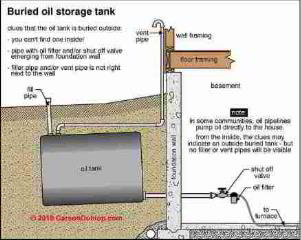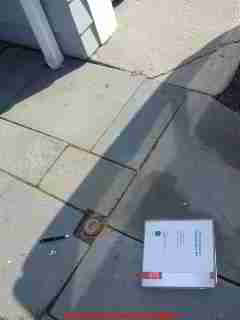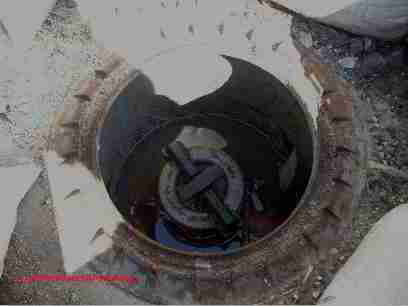 Water Contamination of Buried Oil Tanks
Water Contamination of Buried Oil Tanks
How water leaks into or condenses inside of a buried oil tank - water in USTs
- POST a QUESTION or COMMENT about sources of water contamination in oil storage tanks
Water contamination of oil storage tanks:
This article explains how water gets into buried oil tanks or underground oil storage tanks. We explain how to test for or visually check for water in a buried or above-ground oil storage tank, and how to get water out of an oil tank. Extensive free un-biased oil storage tank inspection and testing advice for property buyers and owners is provided at this website.
This article series explains the problems caused by water accumulation in oil tanks, how water gets into the oil tank, how to measure water in the oil tank, how to remove water from oil storage tanks regardless of whether the oil tank is indoors, outdoors above ground, or buried, and how to prevent water from getting into an oil storage tank.
This website provides detailed information about underground (buried) oil storage tanks (USTs), aboveground oil storage tanks (ASTs), above ground fuel storage tanks, reporting and cleaning up oil tank leaks, and choosing among oil tank leak testing methods. The buried oil tank illustration (above) is provided courtesy of Carson Dunlop Associates, a Toronto home inspection, education & report writing tool company [ carsondunlop.com ].
InspectAPedia tolerates no conflicts of interest. We have no relationship with advertisers, products, or services discussed at this website.
- Daniel Friedman, Publisher/Editor/Author - See WHO ARE WE?
How Does Water Get Inside a Buried Heating Oil Storage Tank

- Water enters a buried oil storage tank by condensation: as temperatures vary moisture-containing air may be drawn into and then out
of an oil tank.
Air leaves the tank as oil is consumed; air enters and leaves the oil tank through the oil tank vent. Moist air entering the tank from outside can bring water which, on entering the cooler tank interior, condenses out of vapor form into water droplets which can, over time accumulate. - Water can enter an underground oil tank through the filler pipe: from roof spillage onto the tank or filler top (particularly and obviously if the filler cap is left off),
or from ground or surface runoff entering the oil storage tank (particularly and obviously if the filler cap is near, at, or below ground surface level).
Leaving off an outside oil tank filler cap for a few days is not itself a likely source of a problem unless the filler was exposed to heavy rain, roof runoff spillage onto the open filler pipe, or surface runoff entering the tank (such as for a filler pipe flush with the ground). - Water leaks into a buried oil tank from an actual tank perforation that admits ground water, or from a bad plumbing fitting on the tank.
When oil levels in the tank is below an oil tank perforation or a leak in oil tank piping, it is possible for ground water to leak into a buried oil tank just heating oil may leak out of the oil tank when it is filled above the perforation or leak point.
- Water leaks into the buried oil tank from a faulty filler cap gasket around the oil tank filler pipe plug, especially at installations whose oil tank filler pipe is located in a box whose top is flush with the ground surface (see our photo, left).
- Water leaks into the buried oil tank from an oil tank vent pipe that is missing a cap to protect against rainwater or roof runoff spillage into the tank, especially if the vent (or filler pipe) are located under the roof's drip-line.
- Water leaks into a buried oil storage tank from leaky oil piping fittings. R.W. Beckett recommends that [Quoting]
All pipe fittings must be tightened securely and have the threads sealed with a resilient compound that can endure the environmental variables in temperature.
Any loose or poorly sealed [oil tank fuel piping, fill, or vent piping] joints can permit ground water to infiltrate the [oil] storage tank.
- Water is delivered to the oil tank along with the heating oil fuel:
This is not common, but it is possible to get a delivery of "bad" heating oil that is water contaminated, especially if the oil truck happens to fill-up at the oil storage depot when an oil barge is unloading oil since during that operation water which is normally kept in the bottom of oil depot storage tanks may be stirred-up.
Most oil companies know to avoid this problem and some also have water filters installed at their oil trucks.
No oil company is going to admit that they picked up and delivered water-contaminated oil to your home so don't waste time asking them if they are guilty of this crime.
R.W. Beckett referred to this [quoting] "possible but rare contributor due to storage and maintenance practices in the [heating oil] distribution system. Large bulk [oil storage] tanks must be checked for condensation accumulation and bled periodically.
If this is not done conscientiously, then it is possible for water to be drawn out with the oil when the stocks are extremely low or when the bulk storage is filled and the water is forced into temporary suspension.
Fortunately, [the heating oil sales and delivery] industry has implemented effective maintenance measures and this has been virtually eliminated.
However, if water and sludge are found in a tank that does not have a leak, then it must be thoroughly pumped out, cleaned, and treated with a chemical additive that disperses water, sludge and neutralizes bacterial growth."
...
Continue reading at OIL TANK WATER DETECTION or select a topic from the closely-related articles below, or see the complete ARTICLE INDEX.
Suggested citation for this web page
BURIED OIL TANK WATER ENTRY at InspectApedia.com - online encyclopedia of building & environmental inspection, testing, diagnosis, repair, & problem prevention advice.
Or see this
INDEX to RELATED ARTICLES: ARTICLE INDEX to HEATING OIL, OIL BURNERS, OIL FIRED HEATERS, OIL TANKS
Or use the SEARCH BOX found below to Ask a Question or Search InspectApedia
Ask a Question or Search InspectApedia
Questions & answers or comments about sources of water contamination in oil storage tanks.
Try the search box just below, or if you prefer, post a question or comment in the Comments box below and we will respond promptly.
Search the InspectApedia website
Note: appearance of your Comment below may be delayed: if your comment contains an image, photograph, web link, or text that looks to the software as if it might be a web link, your posting will appear after it has been approved by a moderator. Apologies for the delay.
Only one image can be added per comment but you can post as many comments, and therefore images, as you like.
You will not receive a notification when a response to your question has been posted.
Please bookmark this page to make it easy for you to check back for our response.
IF above you see "Comment Form is loading comments..." then COMMENT BOX - countable.ca / bawkbox.com IS NOT WORKING.
In any case you are welcome to send an email directly to us at InspectApedia.com at editor@inspectApedia.com
We'll reply to you directly. Please help us help you by noting, in your email, the URL of the InspectApedia page where you wanted to comment.
Citations & References
In addition to any citations in the article above, a full list is available on request.
- "Preventing Water from Entering the [oil heating] Fuel System", Technical Information Bulletin, 10/15/1990, R.W. Beckett Corporation, 38251 Center Ridge Road, PO Box 1289, Elyria OH 44036, Tel: 440-327-1060, Email: sales@beckettcorp.com
- Our recommended books about building & mechanical systems design, inspection, problem diagnosis, and repair, and about indoor environment and IAQ testing, diagnosis, and cleanup are at the InspectAPedia Bookstore. Also see our Book Reviews - InspectAPedia.
- National Association of Oil Heat Service Managers, PO Box 380, Elmwood Park, NJ 07407
- "Homeowners Guide to Fuel Storage," Agway Energy Products, Verbank, NY, November 1990
- In addition to citations & references found in this article, see the research citations given at the end of the related articles found at our suggested
CONTINUE READING or RECOMMENDED ARTICLES.
- Carson, Dunlop & Associates Ltd., 120 Carlton Street Suite 407, Toronto ON M5A 4K2. Tel: (416) 964-9415 1-800-268-7070 Email: info@carsondunlop.com. Alan Carson is a past president of ASHI, the American Society of Home Inspectors.
Thanks to Alan Carson and Bob Dunlop, for permission for InspectAPedia to use text excerpts from The HOME REFERENCE BOOK - the Encyclopedia of Homes and to use illustrations from The ILLUSTRATED HOME .
Carson Dunlop Associates provides extensive home inspection education and report writing material. In gratitude we provide links to tsome Carson Dunlop Associates products and services.


